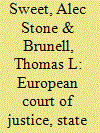|
|
|
Sort Order |
|
|
|
Items / Page
|
|
|
|
|
|
|
| Srl | Item |
| 1 |
ID:
113549


|
|
|
|
|
| Publication |
2012.
|
| Summary/Abstract |
In an article previously published by the APSR, Carrubba, Gabel, and Hankla claim that the decision making of the European Court of Justice (ECJ) has been constrained-systematically-by the threat of override on the part of member state governments, acting collectively, and by the threat of noncompliance on the part of any single state. They also purport to have found strong evidence in favor of intergovernmentalist, but not neofunctionalist, integration theory. On the basis of analysis of the same data, we demonstrate that the threat of override is not credible and that the legal system is activated, rather than paralyzed, by noncompliance. Moreover, when member state governments did move to nullify the effects of controversial ECJ rulings, they failed to constrain the court, which continued down paths cleared by the prior rulings. Finally, in a head-to-head showdown between intergovernmentalism and neofunctionalism, the latter wins in a landslide.
|
|
|
|
|
|
|
|
|
|
|
|
|
|
|
|
| 2 |
ID:
160319


|
|
|
|
|
| Summary/Abstract |
The fact that two senators are elected from each state offers the potential for natural paired comparisons. In particular, examining historical and geographic patterns in terms of changes in the number of divided US Senate delegations (i.e., states whose two senators are of different parties) is a useful route to testing competing models of American politics, including theories of split-ticket voting, party polarization, and realignment. Brunell and Grofman (1998) used divided Senate delegations to indirectly examine evidence for realignment. We hypothesized that a partisan realignment will necessarily lead to a cyclical pattern in the number of divided Senate delegations. We predicted that the number of divided Senate delegations at the state level would decline after 1996 because we conjectured that there had been a realignment cusp around 1980. We tested this prediction with data from 1952–2016 and our prediction was confirmed.
|
|
|
|
|
|
|
|
|
|
|
|
|
|
|
|
|
|
|
|
|